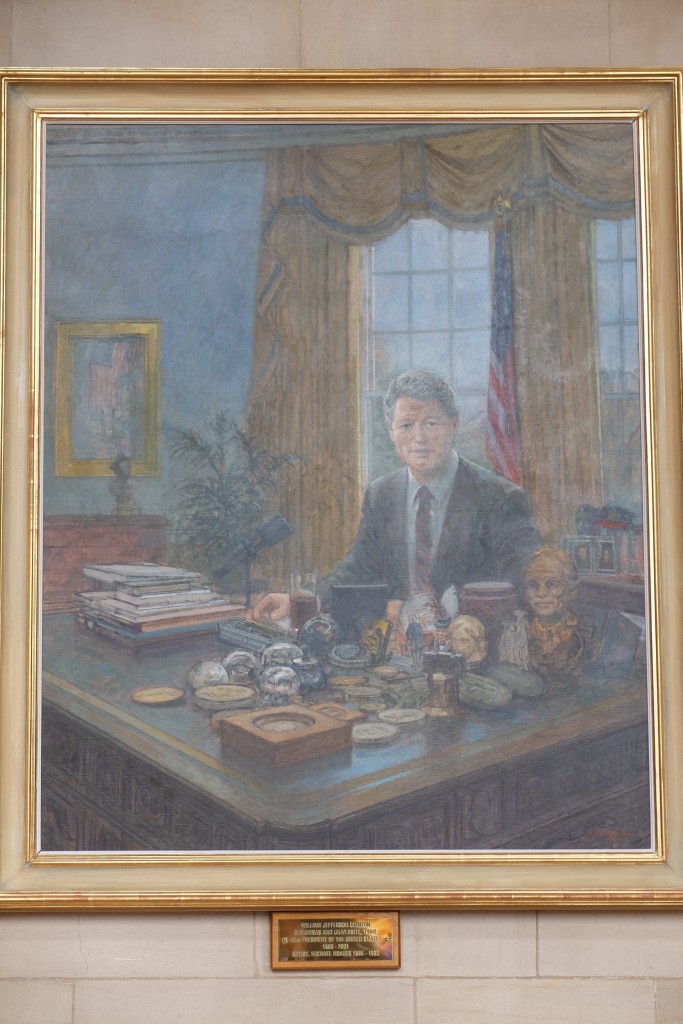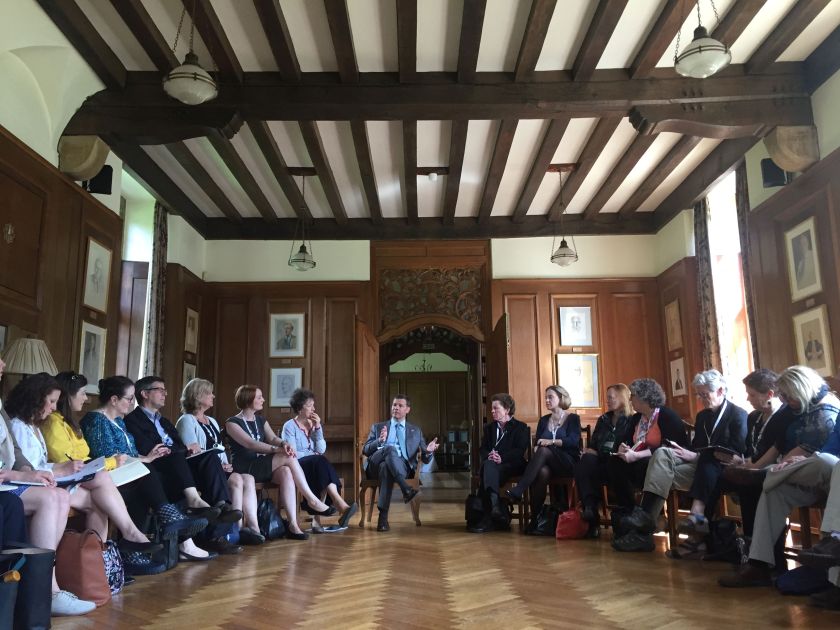Editors’ note: As we await our final three posts—Sheffield (June 7–8), Warwick (June 15–16), and Manchester (June 17)—please savor the following reminiscence of our visit to Oxford University.
University of Oxford (June 15)
http://www.ox.ac.uk/
by Kris Larsen (New York University)
Our time at Oxford was short. Or maybe it was fast. I am not sure which. With six hours on the soil we had just enough time to visit the Rhodes House and the Rothermere American Institute (RAI), hear from Jay Sexton at RAI, learn about graduate study at Oxford, hear about business programs, and walk through the grounds of Corpus Christi College. Then the sky opened up and we found ourselves drenched.
Six hours. I should have known better and I should have looked at our itinerary, because I showed up at Oxford with a list of pubs in my pocket that Jenni Quilter, my partner in crime at NYU, insisted that I check out. It quickly became apparent that I was to save that list for another day. So, instead of a list of pubs, we all came with our preconceptions and six hours in our pocket. And I cannot be sure, but my guess is that many of us had the same thought when we arrived: “Where is this giant bus going to park? There is no bus parking anywhere!” And then we had our first appointment at the Rhodes House. Again, I think a good number of us had the same thought, “So, this is it. . . . Huh.”

I might have been the exception on the tour, but I had no preconceptions for most of the universities we visited. Really, who knew that Imperial College was so good at feeding graduates into the technology industry or that students at Durham could live in a thousand-year-old castle. But Oxford and Rhodes, yes, I had heard of these. C.S. Lewis, J.R.R. Tolkien, Bill Clinton, and all those other people staring down at us from the walls of the Rhodes House: I was well aware that they had attended. Oxford held that grip on me. And maybe understanding that grip was supposed to be my “process” during the trip—or maybe Mary Denyer had planned it like this—but for me, discovering what that grip looked like was essential.

Our day began when Charles Conn, the Warden of Rhodes House, sat down with us. We were in a circle and there was no table. It felt purposefully informal. I don’t remember any other time that the 35 of us sat in such a fashion. The painting of Bill Clinton was two rooms over, and I was having those thoughts, “Here, in this place, I am more suited to a conversation with the groundskeeper.” (In another life I had transplanted a century-old rose garden, built complex sprinkler systems, and found purpose in tending to the aesthetics of the land: dirt-under-the-nails kind of work.) So we sat in a circle, and I thought about the garden while the adults had their conversation. Here are the bullet points from the conversation with Mr. Conn:
- The number of Rhodes awards recently moved from 83 to 95 with a plan to move the total number of awards up to 120 over the next few years. The plan also includes moving the award “toward global.”
- There are still 32 awards for the US competition and 11 for Canada.
- There was mention of the creation of a mid-career award like that of the MacArthur Fellows Program.
- We touched on the role of the adviser with a slight discussion about thematic editing. But the details themselves did not move outside of what we already know and have discussed as NAFAans.
- The selection discussion included references to the need to make “tweaks to the system” and “becoming more inclusive.”
- We were reminded that sports had been replaced by non-academic activities with a focus on working with others.
- We were also reminded that there is an effort to make the review panels more diverse.
- In regard to what a Rhodes Scholar ends up studying once admitted to Oxford, Mr. Conn stated, in a positive way, “We don’t care.” (In other words, it does not have to match up with the application.) A second bachelor’s is a great option, since Oxford is known for the tutorial system, so “don’t discourage your scholars from this option.”
After this conversation we had a short time to walk around the house and grounds, have tea, and speak with current Rhodes Scholars. I felt that this time, having some very forthright conversations, was great, eye opening.
In the same way, our time at RAI, listening to Jay Sexton speak about his time at Oxford (17 years), the university, and its students also felt forthright and eye opening. It was pretty much the opposite of the mystical, unattainable Oxford that my mind had structured. Mary, in referring to Jay’s honesty and clarity, noted this as an example of the ambassadorial potential needed in a Marshall Scholar (of which Jay was one from the University of Kansas many moons ago).
When looking at applications to the kinds of awards that bring a student to Oxford, Jay noted that he looks for ambition regarding the Big Question that the student is approaching and what he or she wants to do. He looks for a tight intellectual case, specificity, and the student’s path to achievement. His emphasis for the need of this kind of clarity in the application comes down to the structure of the Oxford university system: the programs of study are a lot more self-directed, whereas, in the USA, programs are much more structured. So the student who thrives within the structure may find Oxford daunting. And the students, as Jay put it, “are the VERY top students: they might come here.”
Our conversation ended with a discussion of epiphanies. Jay noted how he is put off by both epiphanies and self-centeredness. I realized, then, nobody likes this word “epiphany.” But, well . . . I still kind of like it. Maybe that is because I use it in an odd way, or maybe it is because I look forward to epiphanies on such a regular basis. (I actuality think this could be a great session in Philadelphia this upcoming summer: unpacking the word epiphany. Might be a lively session.)
Now I said that we learned about graduate study at Oxford and the Saïd Business School. And that is true. But somehow at each university we visited the conversation that included the data around applications and admission always took place directly after lunch. Not to say that numbers are dull, I found it quite interesting that 95% of the students in the MBA program are international students, but I would prefer that you not stop your reading of this blog post here. So I am not going to list all the numbers.
After we had our classroom time, we headed into the streets of Oxford. We passed tourists and visitors at every corner. And then we arrived at Corpus Christi College. Like our tours of the colleges at Cambridge, our visit was focused on the outdoor spaces of Corpus Christi. It began at a brick courtyard, no grass, kind of unusual. There was a sundial in the middle of the space. The college felt quaint, almost small. But as we looped out of the courtyard and around the corner we climbed the steps to a roof terrace, just one floor up. From there we could spy on students in grassy fields below sitting in circles and talking. The space felt celebratory, not reflective or contemplative. And it was celebratory. It was a place that marked our short time in Oxford, open skies and gathering clouds.
Then our six hours were over. The sky began to spit at us. We ran through the streets of Oxford, passing the tourists and visitors again, huddling under umbrellas. And once our clothes moved from being just damp to actually being soaked we found our bus. Our structured six hours had ended and we experienced a non-mystical Oxford, beautiful and interesting, and begging for a return visit: a visit unstructured, with a list of pubs stuffed into a pocket.













































































































